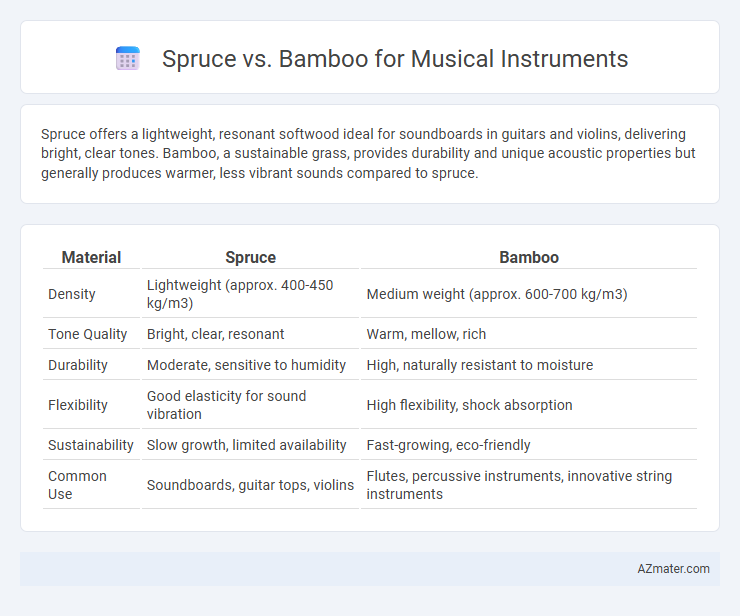Spruce offers a lightweight, resonant softwood ideal for soundboards in guitars and violins, delivering bright, clear tones. Bamboo, a sustainable grass, provides durability and unique acoustic properties but generally produces warmer, less vibrant sounds compared to spruce.
Table of Comparison
| Material | Spruce | Bamboo |
|---|---|---|
| Density | Lightweight (approx. 400-450 kg/m3) | Medium weight (approx. 600-700 kg/m3) |
| Tone Quality | Bright, clear, resonant | Warm, mellow, rich |
| Durability | Moderate, sensitive to humidity | High, naturally resistant to moisture |
| Flexibility | Good elasticity for sound vibration | High flexibility, shock absorption |
| Sustainability | Slow growth, limited availability | Fast-growing, eco-friendly |
| Common Use | Soundboards, guitar tops, violins | Flutes, percussive instruments, innovative string instruments |
Introduction to Spruce and Bamboo in Musical Instruments
Spruce is highly valued in musical instruments for its lightweight, strong, and resonant qualities, making it a preferred choice for soundboards in guitars, violins, and pianos. Bamboo offers a sustainable and eco-friendly alternative, characterized by its natural stiffness and unique tonal properties, often used in flutes, wind instruments, and innovative string instruments. Both materials impact sound quality distinctly, with spruce providing clarity and warmth, while bamboo delivers a brighter, more percussive timbre.
Botanical Origins and Material Properties
Spruce, derived from the genus Picea, is a softwood renowned for its lightweight and high stiffness-to-weight ratio, making it a preferred choice for soundboards in guitars, violins, and other string instruments. Bamboo, a fast-growing grass from the Poaceae family, exhibits remarkable tensile strength, flexibility, and natural resonance, offering sustainable alternatives for instrument bodies and reeds. The botanical distinction between coniferous spruce and monocotyledonous bamboo results in varied cellular structures that influence tonal characteristics, durability, and acoustic performance in musical instruments.
Acoustic Characteristics: Spruce vs Bamboo
Spruce offers a bright, clear tone with excellent resonance and dynamic range, making it a preferred choice for acoustic guitars and violins due to its ability to project sound effectively. Bamboo, while less traditional, provides a unique warm and mellow acoustic quality with natural damping properties that reduce harsh overtones. The stiffness-to-weight ratio of spruce allows for superior vibration transfer, whereas bamboo's density can affect sustain and tonal complexity differently, appealing to players seeking alternative sonic textures.
Common Instrument Applications
Spruce is widely favored for acoustic guitar tops, violin soundboards, and piano lids due to its exceptional strength-to-weight ratio and resonant tonal clarity. Bamboo, increasingly popular in ukuleles and flutes, offers sustainability and unique tonal warmth while maintaining good durability. Both materials provide distinct acoustic characteristics, with spruce delivering bright, articulate sounds and bamboo contributing a softer, mellow timbre in musical instruments.
Durability and Longevity Comparison
Spruce offers superior durability and tonal stability, making it a preferred choice for the soundboard of many high-quality musical instruments, especially acoustic guitars and violins. Bamboo, while eco-friendly and resistant to moisture and cracking, generally lacks the long-term resilience and consistent density that spruce provides, potentially leading to quicker wear under heavy use. Instruments crafted with spruce typically maintain their structural integrity and sound quality over decades, whereas bamboo instruments may require more frequent maintenance or replacement.
Workability and Crafting Challenges
Spruce offers superior workability for musical instruments due to its straight grain and consistent texture, allowing for easier carving and shaping, which is especially important for soundboards. Bamboo, while durable and sustainable, presents crafting challenges because of its hardness and fibrous structure, requiring specialized tools and techniques to achieve precise shaping and smooth finishes. The choice between spruce and bamboo significantly impacts crafting efficiency and final tonal quality in instrument making.
Sustainability and Environmental Impact
Spruce, commonly used for its excellent sound resonance, is often sourced from slow-growing trees, raising concerns about deforestation and habitat loss. Bamboo, a highly renewable grass that matures in 3 to 5 years, offers a sustainable alternative due to its rapid growth and carbon sequestration capabilities. Choosing bamboo for musical instruments reduces environmental impact by minimizing resource depletion and promoting eco-friendly harvesting practices.
Cost and Availability of Spruce and Bamboo
Spruce is widely preferred for musical instruments due to its excellent tonal qualities but tends to be more expensive and less sustainably sourced, leading to limited availability in some regions. Bamboo offers a cost-effective and eco-friendly alternative, with rapid growth ensuring abundant supply, making it increasingly popular for budget-conscious musicians. While spruce remains a traditional choice, bamboo is gaining traction for its affordability and consistent availability in the market.
Influence on Musical Tone and Timbre
Spruce is widely celebrated for its light weight and high stiffness, which contribute to a bright, clear, and responsive tone favored in soundboards of violins, guitars, and pianos. Bamboo, known for its density and natural fibrous structure, imparts a warmer, mellower timbre with enhanced sustain and unique harmonic overtones, making it an innovative choice for eco-friendly instrument construction. The choice between spruce and bamboo significantly influences the instrument's resonance, projection, and tonal complexity, with spruce excelling in clarity and bamboo offering distinctive warmth and richness.
Conclusion: Choosing the Right Material for Musical Instruments
Spruce offers superior resonance and clarity, making it ideal for acoustic guitars and violins, while bamboo provides durability and eco-friendly benefits with distinct tonal warmth. Instrument makers seeking traditional sound quality prioritize spruce, whereas those valuing sustainability and a unique timbre opt for bamboo. Selecting the right material depends on the desired tonal characteristics, playability, and environmental considerations.

Infographic: Spruce vs Bamboo for Musical Instrument
 azmater.com
azmater.com